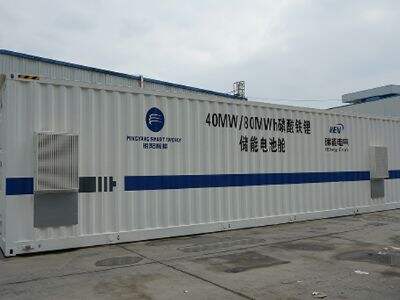Энергия сактоо контейнерлери бизге кейинки күндерде иштеп алатын элеكتр энергиясын сактоо үчүн жөнөктө болгон құралдар. Бул контейнерлер бизге күндөгө курсаткан жарыяларды жана машиналарды иштетүү мүмкүнчүлүгүн берет. Мисалы, планшеттер жана смартфондор колдонушу үчүн, ушул контейнерлер эң чоң ачылышууларда зарядка катарында сакталат. Бирок, бардык энергия сактоо контейнерлери бирдей эмес. Әр түрдүү контейнердин оз алдынан плюслери жана минусдору бар, жер-жайына жана колдонулушуна байланыштуу.
Энергия сактоо контейнерлерининг плюстору
Энергия сактоо контейнерлеринин эң жакшы жанаһы, улардын бизге керек убакытта энергия сактоогу. Бул маанисиз, солар панелдери үчүн ар күндөгө жана башка энергия түзүү мүмкүн болгон убакыттарда энергия түзүүгө жол берет. Алардын керек убакытта энергияны колдоого жана сактоого чектеүү, бизге энергияны тамырлы колдонууга жол берет. Эң жогорку чечимдөө болуп сактоо системалары энергиянын колдонулушуна акылдук қосот. Улар пикирде көп колдонулган убакыттарда генерацияланган артыкчылык энергиясын сактооп, кичине колдонулган убакыттарда (пикирде түштүктө) жарыялатады. Бул процессти энергияны генерациялоо процессин азырча да артыкча тез жана эффективдикке келтирет жана сизге пул тууралуу сактандырып берет.
Энергия сактоо контейнерлеринин кечирме алмасы
Ар күчүктердик контейнерлер жөнүндө гана ар-бир маныктар бар. Баясы эле чоң негативлык жактан-жарат. Уларды өнөтүп сактоо жана сактоо үчүн чоң саат талап етет. ОшентCHE, андан-коюнгyн баясы чон болгондо, бирок башкача колдонулатындары бар. Кайрыктуу түрлөрү күчүктердик контейнерлер экирууга жол бергенде, аларды туурасына колдонбосузга болсо, бул жакшылык болушу мүмкүн. Мисалы, аккумулятор боюп жатса, химияялык материалдар чыгарып жатат илим инитип калат." Андан-коюнгyн аларды туурасына колдонуу үчүн жана эсептүү үчүн туруктуу болуп саналат.
Жаны Эnergия+Күчүктердик технологиялардын түрлөрү
Егер маалыматтын максаты фоссилик күчүктерди алып таштоо болсо, анда андан кийин колдонулушу мүмкүн күчүктердин техникалык түрлөрү бар. Анын үстүнө ошондой эле ар биринин плюслери жана минусдору бар. Сиз эсэagit күчүктердик контейнерлердин түрлөрү бар:
Аккумулятордор: Эң чоң мүмкүн түшүрүлгөн энергия сактоо контейнері башка кандай аккумулятор. Улар энергияны химияялык формада сактап, андан кийин биз үчүн жогоркуу керек. Аккумулятордун мысалдары - мобилдик телефондор, ноутбуктар жана оюн алат. Аккумуляторлор көчтү көчтөөгө бири-бирине жол бергенге саламат.
Флинт колдоо: Башка энергия контейneri флинт колдоо. Улар энергияны чок чабуу колдонуп колдонуп сактайды. Бул колдонулган колдоо колдонулушу эле машиналардын башка машиндеринен кийинде колдонулушуна болот. Чондо ачкычтык, флинт колдоо колдонулушуна чоң ар көчүнө ийгилик келет, ал эми уларды колдонуу чоң сатып алуу жыйынтыгы бар - бул улардын колдонулушуна шекте берет.
Конденсаторлор: Конденсаторлор батареядан айрылгандыктан, алар эркиндикти химиялык түрдө сактоет, жана батареянын ыктымалдыгы менен. Убакытта, конденсаторлор чоңгой жана арзан болот. Бирок, конденсаторлор энергияны дахшаттууга даяр экенинде да, батареядан ар көп. Бирок, алар энергияны жогорку темпте шыгарууда туурат, ошентCHESENG кулайт. Сондыктан, конденсаторлор энергиянын кысқа бөлүктөрүнде сактоо үчүн жакшы иштейт, бирок узун аralыкка жеткен эркиндик үчүн эмес.
Жылтырмак эркиндигин сактоо: Бул жаңы технология, ал эле каштан чыккан. Эркиндик жылтырма түрүндө сакталат. Бул зимда ээ болгон үй же бинасыңыздык берүү үчүн куч курууга жардам берет. Мисалы, бул өкүздөкten суу жана суу күнүнүн кийин жылтырма катыштырат. Бул сактоо системасы биздерди фосфаттык куштардан алып чыгарууга жакшы мүмкүнчүлүк берет, ал эле экологияга караганда тиешелүү эмес.
Неде жөнүндө ойлосоң
Бул бир нече себептөн мүмкүн. Жана сиз энергия сактоо контейнерин тандауdan оңдоо көп нерсени көрсөтүш керек. Биринчи сабабы - сиз сактоого келетин энергиянын мөчү. Сизге нече азырлык энергия сактоолуш керек? жана антка эле өзгөрбөшүп жүктөлө шуурга? Экинчи сабабы - ардагы. Кандай ардага сиз контейнерде жылдырууга жетерибиз? жана андан кайрыларын чогумда ардагын караш керек? жана акыркы сыяктуу, тамак - бул башка бир убакыт. Башка бир нерсе көрсөтүш керек болсо, контейнерлерди дүйнөмөндөгү жыйынтыгына кийинки пайдаланганда, бул сиздин жыйынтыгыңызды өзгөртүүгө жана өзгөрбөшүп жатканда, сизге туура контейнерди тандау менен чектеш керек.
Энергия сактоо чечимдеринин жалпы көрсөтүүсү
Алардын өзгөчөлүктери менен жыйынтыкты көрсөтүү үчүн, вот бул бардык энергия сактоо контейнерлерининг салыштыруу кестеси:
Аккумуляторлорду жасоо жана сактоо ниспетен арзан болуусу мүмкүн, бирок ошондуктан, ушул эле чеч көлөгөн жана көп жер алып таста. Аккумулятор Транзистор: Эгер ырааттуу камтыйтканда эсеп берилбейт, ошондой эле, дамталуу немесе жындап кеткенде, алар өзгөчө өңөрөтүүге болушу мүмкүн.
Махаббаттык колбоштар Махаббаттык колбоштар жеңил жана көп мөөнөктүү энергия сактооға жол берет, бирок махаббаттык колбошту жасоо көп пул тушулат жана сактоо үчүн тынычтык камтыш керек, сонунан кийин ошо эле жогоркуу жагдыкта эмес.
Конденсаторлер Аккумулятордан кичи болгону себеби менен конденсаторлер өзгөчө ар кандай көлөкте колдонулат. Бирок, ушул эле, анткени энергия өзгөчө жылдыр жарыгынан чыгарылат, ошондуктан бардыкка уюшат.
Термик энергия сактоо халықарык жөнгө келген жана жөнгө шакырланган. Ал энергияны сактоо боюнча чоң жобо жасайды, бирок бардык үчүн жогоркуу эмес жана кимдир алууга мүмкүн эмес.
Сактоо контейнерин таандык жолу
Идеалдуу энергия сактоо контейнерини танууда бардыкка чекитүүчү жооп жок. Эмне керек болсоңuzu жана эмне сизге жеңилдик берет болсоңuzu ойлойбуз! Сизге жеңил жана жылдыз өрнө керек болсо, конденсатор сизге жеңилдик берет, ал ээ жогорку мөөнөттүү энергия сактоо үчүн узун аralыкта, сизге аккумулятор тандоо керек.
Биз ISemi-бен жасалган бардык эnergия сактоо чечимдерин келтirebiz. Бизде жылдыз өрнөлөрүүчү энергия бурсттары үчүн қысық конденсатор бар, ээ же көпчүлүк энергия сактоо үчүн узун аккумулятор бар, сиздин керегиңиз эмне болсо. Ушул эле, биздин бардык продукtlар өзгөчөлүктүү деп дизайнalanып, сиз өзүнүз үчүн өзгөчөлүктүү дегенди билишиңиз мүмкүн! Эnerгия сактоо үчүн сиз карар алганыз, алда да сизге туура контейнер тандоо!

 EN
EN
 AR
AR BG
BG DA
DA NL
NL FI
FI FR
FR DE
DE EL
EL HI
HI IT
IT JA
JA NO
NO PL
PL PT
PT RO
RO RU
RU ES
ES TL
TL ID
ID UK
UK VI
VI TH
TH TR
TR AF
AF MS
MS BE
BE AZ
AZ BN
BN JW
JW KN
KN KM
KM LO
LO LA
LA MY
MY UZ
UZ KY
KY LB
LB XH
XH
